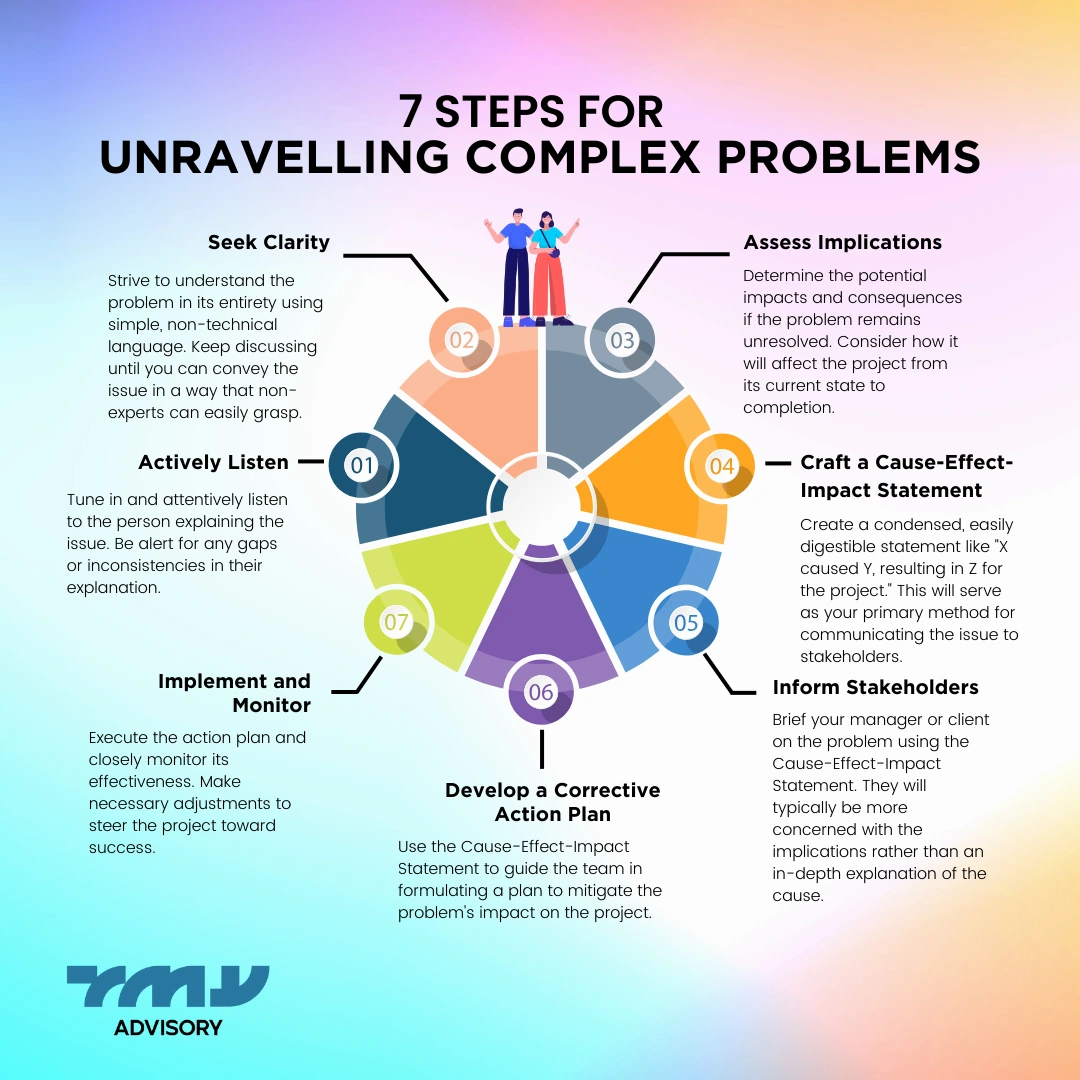Unravelling Complex Project Problems: A 7-Step Guide
In the world of project management, complex problems are an unavoidable reality. Whether it’s due to technical challenges, miscommunication, or unforeseen obstacles, problems can morph into bewildering puzzles. As project managers our task is to cut through the noise and get to the heart of the issue, not only to understand it ourselves but to clearly convey it to clients, stakeholders, and our teams. In this article, we’ll walk through seven strategic steps to untangle complex problems and get your project back on the path to success.
1. Actively Listen
The first step in addressing any complex problem is to engage in active listening. When someone explains an issue, it’s crucial to be fully present, parsing through their words for key information. Listen for gaps or inconsistencies that might signal a misunderstanding of the problem. Active listening also involves asking questions to dig deeper, ensuring that you’re building a comprehensive picture of the situation.
2. Seek Clarity
Once you’ve listened, the next step is to seek clarity. Complex problems often come cloaked in jargon and technical terms that can obscure understanding. Strip away the complexity by asking the explainer to rephrase their points in simple language. Continue this process until you can articulate the problem in terms that anyone, regardless of their technical background, can grasp. This clear understanding is essential for effective problem-solving and communication.
3. Assess Implications
Understanding a problem is more than just knowing its technical aspects; it’s also about grasping its implications. “What will happen if this issue goes unresolved?” Evaluate the potential impacts, including how they might ripple through the project from its current state to completion. Consider both immediate and long-term consequences to prioritise your response effectively.
4. Craft a Cause-Effect-Impact Statement
Communication is key in project management, especially when it comes to complex problems. To aid this, create a succinct Cause-Effect-Impact Statement that encapsulates the problem. This statement should be brief, to the point, and understandable to all stakeholders. For instance, “The delay in steel fabrication (cause) means we will cannot install our lift shafts when planned (effect), and potentially delaying the project by three months (impact).”
5. Inform Stakeholders
With your Cause-Effect-Impact Statement in hand, it’s time to inform your stakeholders. Whether it’s your manager, client, or team, remember that they’re likely more concerned with the implications of the problem rather than its technicalities. Use the statement to brief them on the situation, focusing on how it affects the project’s timeline, costs, and quality.
6. Develop a Corrective Action Plan
Armed with a clear understanding and an effective communication tool, you’re now able to develop a corrective action plan. Use the insights from your Cause-Effect-Impact Statement to guide your team in brainstorming and formulating strategies to mitigate the problem’s impact. Ensure that your plan is actionable, with specific steps, responsible parties, and a timeline.
7. Implement and Monitor
The final step in unravelling complex project problems is to implement your corrective action plan and monitor its effectiveness. This involves tracking progress, measuring results, and being prepared to adjust as necessary. It’s a dynamic process that requires vigilance and flexibility, as no plan is perfect from the start. Continuous monitoring enables you to steer the project back on course and toward a successful completion.
Summing Up
Complex problems in project management can be daunting, but they don’t have to derail your project. By following these seven steps—actively listening, seeking clarity, assessing implications, crafting a Cause-Effect-Impact Statement, informing stakeholders, developing a corrective action plan, and implementing and monitoring—you can simplify the complexities, understand the core issues, and maintain clear communication with all parties involved. This structured approach empowers you to transform chaos into clarity and guide your project through turbulence to triumph.
Project Delivery is a challenging but rewarding experience. The TMY Advisory team is here to support in overcoming complex challenges and achieve success on your project. If the tips in the guide were helpful, or you need support on your projects [Get in Touch] [Learn More About Infrastructure Delivery]




